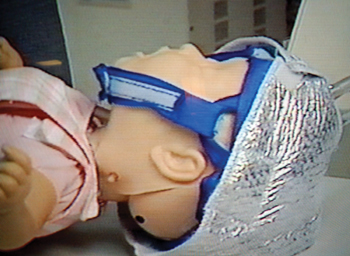
This video image of a mannequin wearing a “CoolCap” was taken from a news report about Vanderbilt’s participation in a study of the device in 1999. The cap has been found to reduce brain damage in some oxygen-deprived newborns.
CoolCap may prevent brain damage after difficult birth
A cap designed to cool the brains of babies born with oxygen deprivation during birth may prevent brain damage.
Vanderbilt Children’s Hospital researchers participated in an international study of the device, “CoolCap,” to cool the brains of full-term babies who were oxygen-deprived and had signs of brain damage within hours of birth. The results are now in.
While the cap offered a moderate overall reduction in brain damage, by about 10 percent, the most promising results were among babies who suffered moderate damage at birth. Those affected by motor damage, such as cerebral palsy, had brain damage reductions of almost 60 percent.
William F. Walsh, M.D., director of nurseries at VCH’s Neonatal Intensive Care Unit (NICU) said it was exciting to be part of the trial.
“The animal data was pretty compelling,” Walsh said, “and we’ve been watching the animal studies for years. These babies are particularly heartbreaking. They’re big and full-term, but there is nothing that can be done for this type of birth injury and it’s hard to stand there and do nothing.”
In the three-year study, from 1999 to 2002, Vanderbilt Children’s Hospital received newborns referred from all of Middle Tennessee. The babies had to be full-term and enrolled within five hours of birth. Because of the stringent requirements, only 13 babies were enrolled. Six babies were monitored and treated with standard therapies as the control group. Seven babies were placed in a CoolCap for a critical 72 hours.
“There seemed to be a short period of time after birth before they began to get worse,” Walsh said. “The concept of using this window of opportunity to prevent a cascade of apoptosis or “cell suicide” by cooling was simple, there was good animal data and there was no alternative at the time the study began.”
Babies were referred following a variety of birth difficulties, including ruptured uterus, placental abruption and cord compression. Brain wave analysis was used at birth to determine the degree of initial brain injury.
Cullen Huff was one of the babies referred to the study after he suffered oxygen deprivation because his umbilical cord was compressed during birth.
It was awful,” said Beverly Huff, Cullen’s mother. “The hospital where he was delivered never got at an APGAR over 5 on him, and when they did a brain scan, they told us there was an 80 percent chance he would be brain damaged.”
Cullen suffered mild to moderate effects of the asphyxiation and was placed in a CoolCap for the study’s prescribed 72 hours.
Huff said today Cullen is a vivacious 4 and a half year old who is writing his name in preschool and is learning to read. He is normal in all respects. Huff says she has made sure to send Walsh a note and photograph every year showing Cullen’s progress because she appreciates the opportunity to take part in the study.
“I’m just thankful they had the study,” said Huff. “Who knows what the outcome would have been otherwise.
“What was most exciting,” Walsh said, “was that at the 18-month follow-up, those babies who were determined to have moderate brain damage at birth showed a significant reduction in signs of cerebral palsy.”
If the most severely brain-damaged babies are excluded; the results look impressive. The number of moderately brain-injured infants who died was reduced from 39 percent to 25 percent. Of infants in the control group, 27.8 percent had signs of a severe neuromotor disability like cerebral palsy, compared with 11 percent of CoolCap babies. That represents a 58 percent reduction in motor abnormalities.
CoolCap did not appear to help all babies. While the brain cooling did not appear to cause any complications for babies, those who had suffered the most devastating brain injuries at the start of their treatment showed no benefit from CoolCap. A new study is now underway to determine the criteria for who is most likely to benefit, and who isn’t.
The international CoolCap trial had 28 centers participating from the United States, United Kingdom, Canada and New Zealand. A total of 218 babies were studied.
The results of the CoolCap trial were presented last week at the annual meeting of the Society for Pediatric Research in San Francisco. The findings are now being submitted for publication in a peer-reviewed journal, and by the manufacturer for review by the Food and Drug Administration. Olympic Medical, manufacturer of the CoolCap, sponsored the trial.













